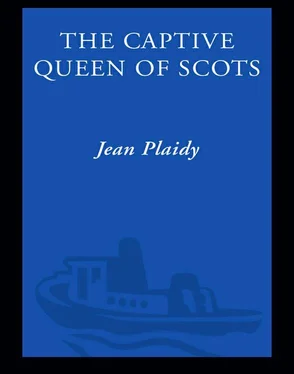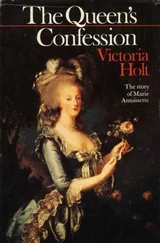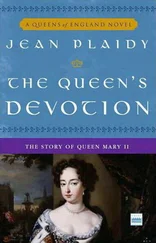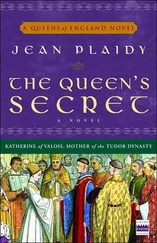Виктория Холт - The Captive Queen of Scots
Здесь есть возможность читать онлайн «Виктория Холт - The Captive Queen of Scots» весь текст электронной книги совершенно бесплатно (целиком полную версию без сокращений). В некоторых случаях можно слушать аудио, скачать через торрент в формате fb2 и присутствует краткое содержание. Жанр: Исторические любовные романы, на английском языке. Описание произведения, (предисловие) а так же отзывы посетителей доступны на портале библиотеки ЛибКат.
- Название:The Captive Queen of Scots
- Автор:
- Жанр:
- Год:неизвестен
- ISBN:нет данных
- Рейтинг книги:3 / 5. Голосов: 1
-
Избранное:Добавить в избранное
- Отзывы:
-
Ваша оценка:
- 60
- 1
- 2
- 3
- 4
- 5
The Captive Queen of Scots: краткое содержание, описание и аннотация
Предлагаем к чтению аннотацию, описание, краткое содержание или предисловие (зависит от того, что написал сам автор книги «The Captive Queen of Scots»). Если вы не нашли необходимую информацию о книге — напишите в комментариях, мы постараемся отыскать её.
The Captive Queen of Scots — читать онлайн бесплатно полную книгу (весь текст) целиком
Ниже представлен текст книги, разбитый по страницам. Система сохранения места последней прочитанной страницы, позволяет с удобством читать онлайн бесплатно книгу «The Captive Queen of Scots», без необходимости каждый раз заново искать на чём Вы остановились. Поставьте закладку, и сможете в любой момент перейти на страницу, на которой закончили чтение.
Интервал:
Закладка:
This was noble, but had little effect on the court. All were condemned to the terrible traitors’ death.
And now the hour was at hand.
The prisoners were taken out of their cells and drawn on hurdles from Tower Hill through the city to St. Giles’s Fields where a scaffold had been erected.
The crowds were waiting to see these men die perhaps the most horrible death which man could devise.
Ballard, brave to the end, was the first to die.
So those who were condemned to die under similar diabolical circumstances watched their fellow conspirator hanged, cut down before he was dead and disemboweled while still alive by the executioner’s knife.
It was the turn of Babington. Determined not to falter he faced the crowd and told them that he had not joined the conspiracy for private gain but because he believed he was engaged in a deed both lawful and meritorious.
The hands of the executioner were upon him.
He was still alive when they cut the rope about his neck. He saw the executioner’s knife poised above his suffering body; he felt the sharp steel pierce his flesh.
Gone were all the dreams of Earthly greatness.
“Parce mihi, Domine Jesu,” he murmured.
And thus he died.
IN THE STREETS the people were talking of that scene of revolting cruelty. John Savage had broken the rope on which he was hanged; and the terrible mutilation had been endured while he still lived.
When news of the execution was brought to Elizabeth, she asked for a truthful answer as to how the spectators had acted; and when she heard that they had witnessed the scene in silence, she gave orders that it was not to be repeated on the next day when other conspirators were to be executed.
Those who had taken part in the Babington plot and were due for execution on the next day were more fortunate than those who had suffered before them. The Queen ordered that they were to be hanged by the neck until they died.
ELIZABETH was pensive.
The time had come, Burleigh assured her, to take action against the Queen of Scots. Walsingham was in complete agreement with him.
In her hand the Queen held a letter from Leicester, who was in Holland. He was shocked beyond expression, he wrote, that the wicked woman of Scotland had schemed against the life of his beloved Queen. The easiest method of preventing such an occurrence being repeated was to administer a dose of poison. This, urged Leicester, was legal in the circumstances and would relieve his dear mistress of the anxiety he knew she would feel if obliged to sign the death warrant of one who was a Queen even as she was herself.
No, Robert, thought Elizabeth. I will not be accused by my Catholic subjects of her murder.
But what to do?
“Bring her to the Tower,” suggested Walsingham.
But the Queen shook her head. She did not forget that there was a strong Catholic party in London. It had shocked Elizabeth deeply, to learn that there were among her subjects those who could conspire against her. The number involved in the Babington plot was startling; and they were but a minority of the Catholics who were prepared to work against her.
“I shall not have her brought to London,” she said. “She shall go to Fotheringay Castle and there be tried. If she should be found guilty, there shall she meet her fate.”
XVIII
Fotheringay
FOTHERINGAY!
Mary was filled with foreboding as she came to her new prison. She had been separated from many of her friends before she left Chartley, and among these was Barbara Curle who wept bitterly at the parting; but Elizabeth Curle, whom Mary dearly loved, was allowed to accompany the Queen to Fotheringay, as was Jane Kennedy. Andrew Melville, her Master of the Household, was also with her.
The castle was a grim fortress standing on the north bank of the River Nen in Northamptonshire. Mary did not think of escape as she had on entering other prisons, for a sense of inevitable doom had possession of her and she believed that she would never leave this place alive.
When her party had crossed the drawbridge they entered a court which led to a large hall. Mary stood for a few moments looking at this hall before Paulet said harshly that she was to be conducted to her apartments.
They passed a chapel and he led the way to the rooms which had been set aside for her use. They were large, and pictures graced the walls.
As holding her little Skye terrier in her arms, she followed Paulet, she felt the little creature’s heart beating wildly.
“Be still, little one,” she murmured. “At least they have not parted us . . . and never shall they . . . while I live.”
IN THE GREAT HALL of Fotheringay the dais was emblazoned with the arms of England, and on this dais was a chair covered in red velvet.
In this hall were gathered the lords of England, come to try Mary for her part in the plot to assassinate their Queen, and among them were Lord Burleigh and Sir Francis Walsingham. Elizabeth was represented by the Attorney-General, the Solicitor-General and the Queen’s Sergeant. Mary was to defend herself.
She was pleased to have with her at this perilous time Sir Andrew Melville who, as the Master of her Household, was entitled to accompany her; on his devotion and affection she placed great reliance; but she knew that it could avail her little, for all those men who had come from London to Fotheringay had determined to find her guilty.
The Queen’s Sergeant, Sir Thomas Gawdy, colorful in his blue robe with the red hood falling on his shoulders, stood up to open the case. He spoke of the information obtained from Babington and his fellow conspirators; he explained that six of them had planned to murder Queen Elizabeth. There were letters, he said, which would prove Queen Mary guilty of partaking in this plot.
Depositions had been taken from her secretaries, Jacques Nau and Gilbert Curle, which would prove the case against her.
Mary stared blankly before her, wondering what torture those two had suffered before they had betrayed her. She did not know that they had refused to betray her, that they had been trapped into making certain admissions and that Jacques had written to Queen Elizabeth assuring her of Mary’s innocence in any plot to assassinate her. Jacques and Gilbert were still in prison because of their persistent loyalty to their mistress.
But how could she learn that in this sad hall of doom?
She was thinking back to that day when Babington’s letters had arrived, trying to remember exactly what he had written, exactly what he had said.
She demanded to see the letters and triumphantly pointed out that they were in the handwriting of one who had deciphered them; and could not, she asked, the decipherer have written what he wished? How could they prove that they were letters written by her when they were not in her handwriting?
In a moment of folly she denied knowing Babington; but she added: “It is true that I have heard of him.”
She was reminded that Babington had confessed that correspondence had passed between them, and that the assassination of Elizabeth had been part of the Babington plot.
“Gentlemen,” cried Mary, “you must understand that I am no longer ambitious. I wish for nothing but to pass my days in tranquillity. I am too old now, too infirm to wish to rule.”
“You have continually asserted your pretensions to the throne of England,” Burleigh accused her.
“I have never given up asserting my rights,” answered Mary cryptically, and Burleigh was somewhat nonplussed because there were many who doubted the legitimacy of Elizabeth, and it was impossible to know whether some of them were present.
She attacked Walsingham, calling him an enemy who had deliberately set out to entrap her. “I never thought to harm the Queen of England,” she cried. “I would a hundred times rather have lost my life than see so many Catholics suffer for my sake.”
Читать дальшеИнтервал:
Закладка:
Похожие книги на «The Captive Queen of Scots»
Представляем Вашему вниманию похожие книги на «The Captive Queen of Scots» списком для выбора. Мы отобрали схожую по названию и смыслу литературу в надежде предоставить читателям больше вариантов отыскать новые, интересные, ещё непрочитанные произведения.
Обсуждение, отзывы о книге «The Captive Queen of Scots» и просто собственные мнения читателей. Оставьте ваши комментарии, напишите, что Вы думаете о произведении, его смысле или главных героях. Укажите что конкретно понравилось, а что нет, и почему Вы так считаете.










